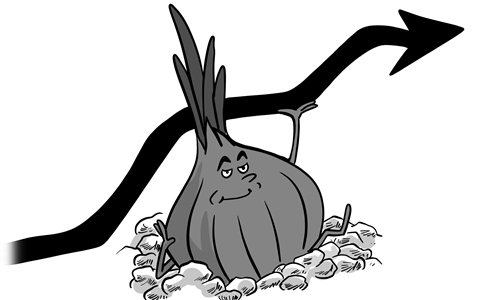HOME >> BUSINESS
Struggling Indian economy set to continue slowdown amid repetitious onion crisis
Source:Global Times Published: 2019/11/27 20:48:40

Illustration: Luo Xuan/GT
India's GDP growth is expected to slow further to a rate below 5 percent in the 2019-20 fiscal year, as the country's inflation level has been increasing amid developments in its onion crisis. The skyrocketing price of the vegetable ubiquitous in Indian cooking could lead to increased social problems. The overlap of rising inflation and the economic slowdown is sounding the alarm of potential stagnation for the Modi administration.The onion crisis, which has plagued India several times over past decades, has returned. A drop in supply, due to crop damage from heavy rains and flooding in large parts of India, has caused a supply shortage and subsequent rise in prices. To rein in this rise in prices, the Indian government in September announced a ban on onion exports, which has in turn caused onion supply shortages and price rises in countries like Bangladesh.
The vegetable is a significant indicator of the livelihood of Indian people. A surge in its price will provoke social discontent, and a drop in price will stir dissatisfaction among farmers. The repetitious onion crisis has an established spiral: weather factors lead to a price surge, the government bans exports and cracks down on stocks to rein in prices, prices return to normal due to production recovery, prices sink due to overproduction, the government relaxes export restrictions, and prices finally rise before the cycle begins anew. Indian Prime Minister Narendra Modi pledged to boost India's economy to a new high during the country's May election. To realize this ambitious promise, his most urgent priority has become breaking out of the onion crisis cycle. From April to June of 2019, India's actual GDP growth was just 5 percent, far below expectations. India's GDP growth has remained under 6 percent for two consecutive quarters, and the prime minister's economic policies now face serious challenges.
Modi's election win in May was largely thanks to pledges he made to the Indian people, including infrastructure investment, support for farmers and agricultural production. However, the space for India to carry out fiscal policies is being squeezed.
The soaring onion prices have driven inflation levels higher, particularly in the food sector, which is bad news for the Reserve Bank of India and the Modi government. The swelling inflation is worrisome as the government is making interest-rate cuts to deal with the economic slowdown.
There are clear cyclical reasons for this slowdown. The last round of growth began with credit expansion, and a rise in non-performing loans has led to deleveraging. Deleveraging has curbed credit expansion, dragging down economic growth. A cyclical slowdown could see recovery when liquidity is injected and consumption recovers.
However, a closer look at India's economy reveals that the fundamental reason for its cyclical fluctuation is an inherent structural contradiction. India's economic growth is solely dependent on a drive for consumption, rather than a more balanced drive for consumption, investment and exports. Additionally, the country's consumption increases come from credit expansion rather than the improvement of productivity. Its single-engine driving force is not stable and will inevitably increase the frequency of the cyclical fluctuation. So, unless private investment and exports can be improved, India's current growth pattern will continue to be turbulent.
India's fiscal expenditure has risen compared to last year. The increase, however, is due to capital expenditure rather than running expenses, and are mostly government subsidies promised by Modi during his election campaign. Meanwhile, the government has halted a road projects due to a shortage of funds. Such an expenditure structure is not conducive to solving the fundamental problems suppressing India's economic growth.
An inflation rise amid an economic slowdown is also hurting the nation's consumers, particularly its low-income consumers. India is faced not only with the challenge of boosting its economy, but also the challenge of protecting its most vulnerable people. Against this background, the current onion crisis is a test of Modi's resolve in carrying out structural reform and opening-up.
In order to break through the roof blocking India's economic growth, Modi's government must understand that the country needs to promote reform and opening-up to prevent its structural issues from cementing it in a stagnant cycle, just like the onion crisis that haunts the country again and again.
The article is based on an interview with Liu Xiaoxue, an associate research fellow at the National Institute of International Strategy of the Chinese Academy of Social Sciences. bizopinion@globaltimes.com.cn
Posted in: EXPERT ASSESSMENT